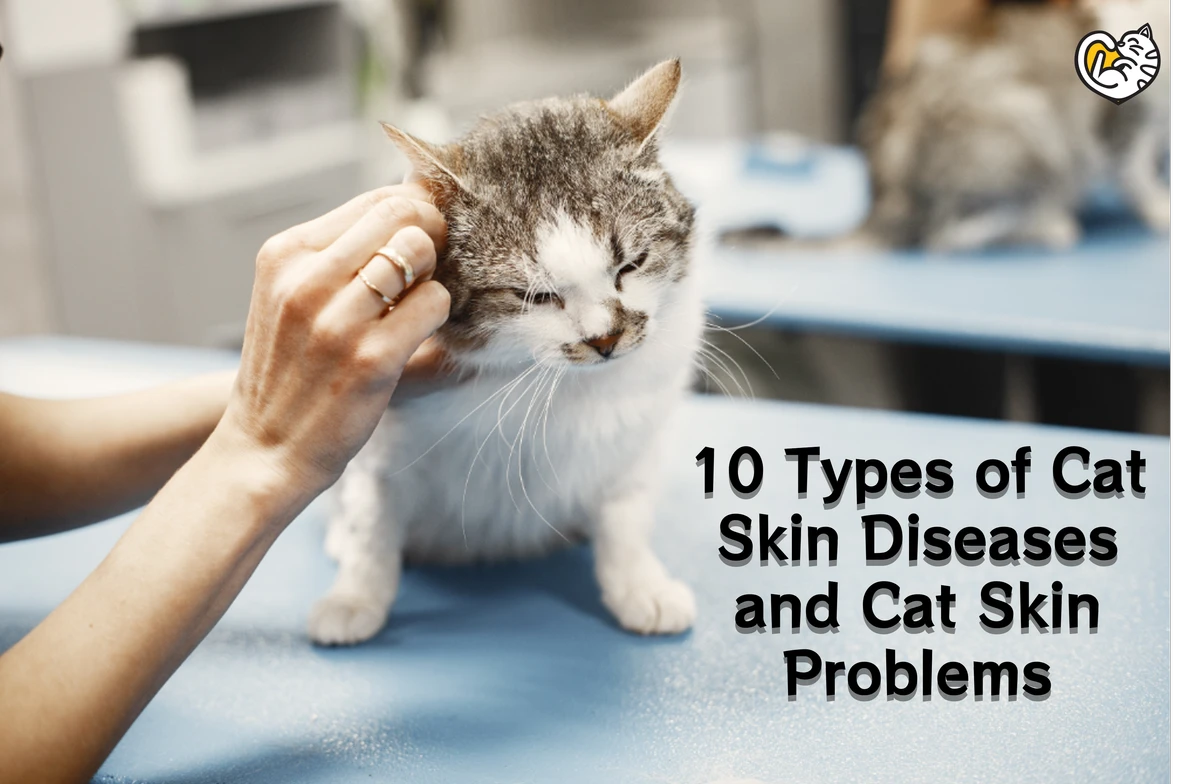10 Types of Cat Skin Diseases / Cat Skin Problems


Cat's skin plays a crucial role as a protective barrier, and any skin condition can compromise this defense mechanism. Cats, varying by breed, exhibit diverse fur lengths, contributing to their appearance and overall well-being.
Beyond aesthetics, the skin shields cats from external elements, regulates body temperature, and acts as an immune barrier against infections. When a cat experiences a skin condition, it not only weakens their natural defenses but also often leads to significant discomfort.
Given that a cat's skin is readily visible, it serves as a noticeable indicator of their overall health. If your furry friend seems uneasy, constantly scratching or biting, it might signal discomfort.
Skin problems, often provoked by parasites like fleas, can lead to distress and fur loss. Injuries, dirt, and diseases can also trigger skin conditions. If your cat endures bites from other animals, prompt veterinary attention is crucial to prevent complications like fur loss, deteriorating health, and significant dermatological issues.
Detecting cat skin diseases is relatively straightforward due to this visibility. However, it's essential to recognize that there are numerous potential causes for skin diseases in cats, making a visit to the vet imperative for an accurate diagnosis.
In this guide, we will explore the most prevalent cat skin conditions, shedding light on their symptoms, causes, and potential treatments. Understanding these conditions is vital for ensuring the well-being of your feline companion and addressing any skin issues promptly.
Is Your Cat Picky About Food?
Well, my cats used to be like that too, but now they finished the food all the time!
If your cat doesn’t want to eat the food or finish the food you gave, I have a solution for you. Read my true story here.
Understanding Common Cat Skin Problems
Cats, like any living beings, can face various skin issues that demand attention and care. Let's explore some common feline skin problems and how to manage them.
1. Acne:
- Cause: Bacterial overgrowth and increased keratin production.
- Symptoms: Pimples and black spots under the lips and chin.
- Treatment: Medicated shampoos, ointments, warm compresses, and Omega-3 supplements. Topical antibiotics can reduce swelling.
2. Scabies:
- Cause: Mites infesting the skin.
- Symptoms: Inflammation, swelling, and fur loss.
- Treatment: Topical medications, flea control treatments, and providing a new bed if diagnosed.
3. Ear Mites:
- Cause: Common in cats of all ages, especially kittens.
- Symptoms: Scratching and licking ears.
- Treatment: Topical treatments like moxidectin, ivermectin, and selamectin. Cleaning ears with a vet-recommended solution.
4. Ticks:
- Cause: Blood-sucking parasites, often found in outdoor cats.
- Symptoms: Visible ticks, larger in size.
- Prevention: Regular checks, flea preventative treatments administered by a veterinarian.
5. Environmental Allergies:
- Cause: Sensitivity to everyday items like chemicals, pollen, grass, dust, or food.
- Symptoms: Excessive grooming to remove foreign particles.
- Management: Observation for signs of discomfort, bathing, and preventive measures against environmental stressors.
6. Alopecia Due to Stress:
- Cause: Sudden changes in behavior patterns, indicating stress.
- Symptoms: Excessive shedding, thinning of fur on the belly and back.
- Solution: Catnip, pheromones, and addressing environmental stressors.
7. Food Allergies:
- Cause: Allergic reactions to certain proteins and carbohydrates.
- Symptoms: Inflammation around the head, neck, and back.
- Treatment: Identifying and eliminating trigger components from the cat's diet.
8. Swelling with Suppuration:
- Cause: Physical injuries, bites, and wounds from other animals.
- Symptoms: Purulent swelling, open wounds.
- Action: Seek professional care from a veterinarian, follow prescribed healthcare protocols.
9. Fungal Infection:
- Cause: Fungal action, highly contagious.
- Symptoms: Red circles, excessive shedding.
- Treatment: Professional intervention, consultation with a vet.
10. Endocrine Dermatosis:
- Cause: Hormonal imbalance.
- Symptoms: Dry fur, increased shedding, itching, dandruff.
- Management: Spaying/neutering, topical medications, prescription shampoos under vet guidance.
Knowing the signs and appropriate responses to these skin issues ensures your cat's well-being. Always consult with a veterinarian for accurate diagnosis and tailored treatment plans.
Identifying Signs of Cat Skin Problems
Recognizing the signs of skin issues in your cat is crucial for providing timely care. Here are common indicators that your feline friend may be experiencing skin problems:
- Hair Fall:
- Sign: Excessive hair loss.
- Action: Consult a healthcare provider if your cat is balding.
- Itchy Skin:
- Signs: Itchy skin, fur loss, and inflammation.
- Observation: Cats may groom excessively to alleviate discomfort.
- Scabies:
- Signs: Cuts, sores, and potential behavior changes.
- Immediate Action: Seek prompt medical attention to prevent bacterial contamination.
- Other Signs:
- Rashes: Indicate significant skin issues.
- Flaky and Dry Skin: May result in discomfort.
- Skin Warts and Bumps: Indicate varying skin problems.
Home Remedies for Cat Skin Problems
Here are some of the home remedies for cat skin problems:
- Tea Bath:
- Ingredients: Chamomile, calendula, and green tea.
- Benefit: Soothes skin inflammation and itching.
- Application: Provides relief for certain types of cat skin diseases.
- Apple Cider Vinegar and Water Spray:
- Solution: Mix apple cider vinegar with water.
- Effect: Soothes flaky and itchy skin, addresses allergies and rashes.
- Coconut Oil:
- Benefit: High anti-bacterial and anti-fungal properties.
- Application: Relieves infections, allergies, and insect bites.
Note: While these remedies can help with mild conditions, serious skin problems necessitate professional care. This may involve antibiotics, topical medications, and ointments prescribed by a veterinarian.
Always monitor your cat's condition closely, and consult with a vet for an accurate diagnosis and appropriate treatment. Your cat's well-being is best ensured through a tailored healthcare approach.
How to Prevent Cat Skin Conditions
Preventing cat skin conditions is crucial for their overall well-being. Here are some effective measures you can take to support your cat's skin health:
1. Feed Them a High-Quality Cat Food
Start by feeding your cats a high-quality diet such as the freeze-dried pet food. A nutritious diet contributes to healthy skin and a shiny coat. Poor-quality diets can lead to skin issues and a lackluster coat.
2. Maintain a Healthy Weight
Ensure your cat is at an appropriate weight, neither underweight nor overweight. This helps them continue grooming throughout their life, promoting good skin health.
3. Use Flea and Tick Control
Even indoor cats can be vulnerable to parasites like fleas and ticks. Regular use of flea and tick preventatives is essential to prevent infestations. Parasites can contribute to itching and skin problems, even in seemingly protected indoor environments.
4. Manage Stress Levels
Minimize stressors in your cat's environment to reduce the risk of psychogenic skin issues, such as overgrooming. Consult your veterinarian for stress-relieving products, including cat pheromone diffusers.
5. Assist with Grooming When Needed
While cats are generally adept groomers, some may need assistance, especially older or overweight cats. Use tools like a damp rag and a rubber grooming brush to assist with grooming. Avoid excessive bathing or grooming, as it can lead to its own set of problems.
Remember, a proactive approach to your cat's skin health can prevent many common skin conditions. Regular veterinary check-ups and early intervention can address any emerging issues and ensure your cat enjoys healthy skin throughout their life.
How Grace Cat Products Safeguard Against Cat Skin Diseases
Grace Cat products have gained popularity among cat owners for their rich nutrient content, providing a robust immune system that not only prevents feline skin diseases but also safeguards against various health issues.


The freeze-dried pet food from Grace Cat is abundant in natural protein components, promoting the growth of your cherished kitten and eliminating disease-causing bacteria. Packed with essential vitamins and minerals,
Grace Cat freeze-dried pet food ensures a healthy and well-conditioned life for your cat. Suitable for both adult cats and kittens, these products provide the energy needed for a vibrant and adventurous life, ensuring your cat maintains a healthy skin, free from issues like rashes and excessive shedding. Choose Grace Cat for the well-being of your feline companion.
Can Scabies in Cats be Cured?
Certainly! Scabies in cats can be effectively treated with topical medications and flea control treatments. Your veterinarian may recommend different forms of topical medications such as injections, shampoos, or dips. Additionally, measures to eliminate the mites causing scabies, along with antibiotics and anti-inflammatories to address the skin condition, may be part of the treatment plan.
Why is My Cat's Skin Dry and Flaky?
When it comes to dry and flaky skin in cats, several factors could be responsible, including food allergies, environmental allergies, and fungal activity. To address this issue, consider incorporating more Omega-3, zinc, and fatty acids into your cat's diet. Home remedies like apple cider vinegar and water sprays can also be helpful in managing dry and flaky skin.
Why Does My Cat have Scabies but No Fleas?
It's important to note that scabies in cats doesn't always imply the presence of fleas. Various factors, such as environmental allergies, dirt, and injuries from fights with other animals, can contribute to scabies. Topical steroid creams are often recommended to alleviate itching and discomfort associated with scabies, even in the absence of fleas.
Can Cat Scabies Heal on Its Own?
Scabies, caused by mites and ticks on the cat's skin, typically does not heal on its own. Proper steps must be taken to eliminate the mites. Once the mites are eradicated, the application of topical medications and ointments can aid in a faster recovery from scabies.
How Long does It Take for a Cat to Recover from a Skin Disease?
The duration of recovery from a skin disease in cats varies based on factors such as age, lifestyle, and the severity of the condition. Generally, cats can recover within 8 to 10 weeks once allergy symptoms have subsided. If you suspect your cat has a skin condition, seeking prompt veterinary attention is advisable for a more accurate diagnosis and tailored treatment plan.
Do you know the biggest challenge faced by cat owners?
It’s not what you think. Find out the answer here (before it’s too late).





